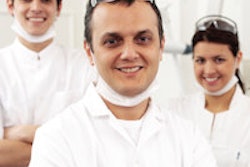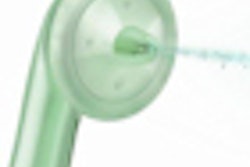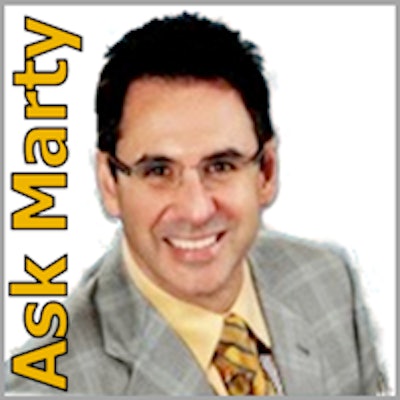
Q: What was new at the 2011 IDS meeting?
A: Many U.S. dentists have never heard of the International Dental Show (IDS). Held every other year in Cologne, Germany, it is the largest dental show in the world; this year there were more than 120,000 participants and nearly 2,000 exhibitors in an exhibit area covering some 36 acres.
IDS is quite different from U.S. dental shows. There are no continuing education classes, although there are many learning opportunities available in vendors' booths. In some booths, there were actual surgeries being done that you could observe, and you get every opportunity to get up close and personal with both equipment and materials. There is no rush when talking to the salespeople; in fact, many booths have refreshments and food available.
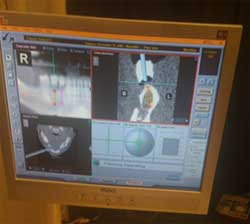 The Implant Guided Implant system from Image Navigation.
The Implant Guided Implant system from Image Navigation.The most interesting product I saw was from Image Navigation, which has developed Implant Guided Implant (IGI), a hardware and software system that acts like a GPS for implant training and implant placement. A CT scan is acquired and loaded into the software.
The company provides a special implant drill, and a receiver is placed over the teeth that serves as a reference. When you move the drill, the device detects where the drill is in relation to the CT scan, providing real-time interoperative navigation. Think of it as flight simulator software for implant placement.
The second most interesting item costs less than $1 and comes from Erskine Dental, an Australian company. It's called Super Daps. They are composite bonding dappen dishes that are incredibly well designed.
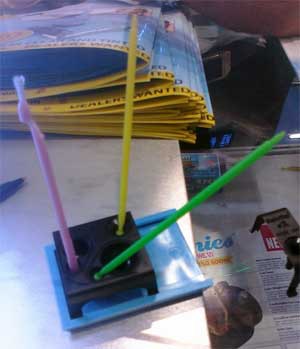 Super Daps composite bonding dappen dishes by Erskine Dental.
Super Daps composite bonding dappen dishes by Erskine Dental.When the bonding agent is placed in the dish, evaporation is reduced, which stops the agent from setting for up to 24 hours. The Preeben brushes are designed to fit precisely into the wells and help reduce the evaporation. They are available in many designs to accommodate your every bonding need.
The largest crowds were at the Philips booth, where the company was showing off the new Sonicare AirFloss, designed for interdental plaque removal. The AirFloss features microburst technology, which is said to remove up to 99% more plaque in between teeth than brushing with a manual toothbrush alone, according to Philips consumer testing.
A number of intraoral and impression scanners were on display as well. 3Shape was showing its new intraoral scanner, the Trios. It's similar to Cadent's iTero but operates more like 3M ESPE's Lava COS. Heraeus Kulzer and Planmeca both distribute this unit, and MyRay has a similar device that is relabeled by several other companies.
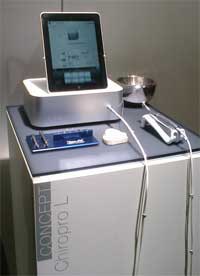 An iPad controls the ChiroPro motor from Bien-Air.
An iPad controls the ChiroPro motor from Bien-Air.3Shape was also exhibiting an impression scanner, as was Dental Wings. These devices are designed to scan a conventional crown and bridge impression. Dental laboratories are currently buying most of these scanners, but you can expect to see them in your dental office in the not-too-distant future. The impression is scanned and the data uploaded to the dental lab, where the prosthesis is designed and fabricated.
An adjunct for full arch implant impressions is the PIC Camera from PIC Dental. Special black wings with white dots are attached to the implant. The PIC Camera recognizes the PIC abutments and exports the exact position between implants along with the angles and interrelated distances. Along with a conventional impression, the implant framework can be fabricated, which should eliminate the need for sectioning the framework.
Bien-Air had an iPad controlling its ChiroPro motor, but this device is not available in the U.S. Also, check out Bien-Air's new short electric handpiece motor, which reduces the size and weight of the handpiece.
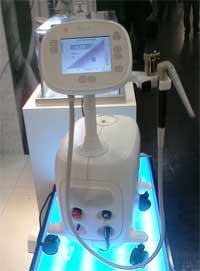 The LiteTouch erbium hard-tissue laser from Syneron.
The LiteTouch erbium hard-tissue laser from Syneron.Another device sporting an iPad was the Picasso Laser from AMD Lasers. The iPad does not control the laser but is used to provide information and videos for assistance in doing diode laser procedures. AMD was also showing the upcoming dual-wavelength erbium and diode hard- and soft-tissue laser that will retail for $25,000. Look for new Picasso diode lasers in the future.
Syneron is awaiting FDA approval for the LiteTouch erbium hard-tissue laser with a smaller form factor than we in the U.S. are used to. I did some cutting with this laser, and it had a very nice handpiece and seemed to cut very efficiently.
Planmeca was showing the Promax 3D Proface CBVT. The machine produces a realistic 3D face photo in addition to the traditional 2D and 3D radiography in a single scan. The acquiring of the photo is radiation-free and is done through the use of a laser scan for the facial geometry. Digital cameras capture the color and texture of the face into a 3D photo that can be analyzed as a separate image or combined with the CBVT image. This allows for visualization of facial features for orthodontic, prosthodontic, and oral maxillofacial surgical procedures.
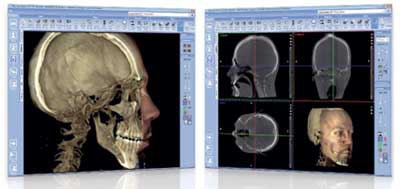 The Promax 3D Proface CBVT system by Planmeca.
The Promax 3D Proface CBVT system by Planmeca.Look for Sirona to be combining Cerec scans with its cone-beam CT systems in the near future, allowing the viewing of the condular position in various restored positions prior to milling of restorations.
I am a fan of using ozone in my office, and for those interested in ozone therapy, CurOzone has reintroduced its healOzone unit, at a price of $12,500. The new unit can use both standard air and medical-grade oxygen for higher concentrations (which I recommend). Ozone can be an adjunct therapy for many dental procedures as it is virucidal, bactericidal, and fungicidal. Ozone therapy can assist in caries therapy, remineralization, and periodontal therapy.
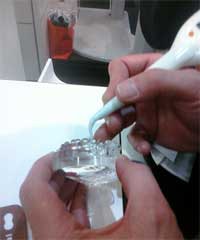 Orange Dental's new cordless periodontal probing device.
Orange Dental's new cordless periodontal probing device.I saw another smaller ozone unit from DentaTec Dental-Handel for $5,000, but I could not get a lot of information on the unit as all the literature was in German.
Orange Dental was showing a new cordless periodontal probing device with software. The measurements can be viewed on the desktop software along with a display on the device itself. The disposable probe is inserted into the pocket with 20 g of pressure. The probe retracts into the device, and you wait for the software to read the pocket depth. The measurement is then populated into the software. This perio probe is currently not available in the U.S.
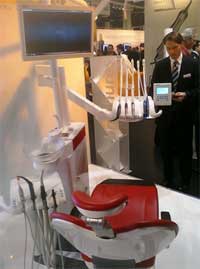 The Sinius unit by Sirona.
The Sinius unit by Sirona.Finally, Sirona introduced some new dental operatory equipment, including the Sinius. The units are upgradable and are connected to the Internet to assist in diagnosing problems so that the repair people will know the problem and bring the correct parts. There is a smart touchscreen that knows which handpiece has been selected and gives you the appropriate options. The chair is controlled with a small joystick foot controller and has an integrated handpiece maintenance station.
Marty Jablow, DMD, lectures and consults extensively about integrating technologies into the modern dental practice (www.dentaltechnologycoach.com). If you've got a technology question for Dr. Jablow, send it to [email protected].
The comments and observations expressed herein do not necessarily reflect the opinions of DrBicuspid.com, nor should they be construed as an endorsement or admonishment of any particular idea, vendor, or organization.


.hpp4JFpXkV.png?crop=focalpoint&fit=crop&fp-x=0.5&fp-y=0.5&h=100&w=100&auto=format%2Ccompress&q=70)


